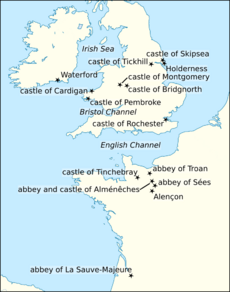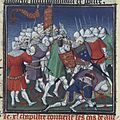Arnulf de Montgomery facts for kids
Quick facts for kids
Arnulf de Montgomery
|
|
|---|---|
| Earl of Pembroke | |

Arnulf's name as it appears on folio 67v of Oxford Jesus College 111 (the Red Book of Hergest): "ernỽlf uab roser".
|
|
| Born | c. 1066 |
| Died | 1118/1122 |
| Noble family | Montgomery |
| Wife | Lafracoth |
| Issue | Robert MacCimbric Alice de Montgomery |
| Father | Roger de Montgomery |
| Mother | Mabel de Bellême |
Arnulf de Montgomery (born around 1066; died between 1118 and 1122) was an important Anglo-Norman lord. He was a younger son of Roger de Montgomery and Mabel de Bellême. Arnulf's father was a powerful leader in Normandy and England. He played a big part in the Anglo-Norman invasion of Wales in the late 1000s.
After his family's victories against the Welsh, Arnulf settled in Pembroke. He built a castle there from earth and timber. He was likely given the title Earl of Pembroke for his efforts.
Around the year 1100, Arnulf's power grew greatly. His lands included much of the former Welsh Kingdom of Deheubarth and some areas in Yorkshire. Not long after this, Arnulf helped his older brother, Robert de Bellême, in a rebellion against Henry I, King of England. Around this time, Arnulf also married Lafracoth, a daughter of Muirchertach Ua Briain, King of Munster. This marriage was probably an attempt to get military help against the English king.
However, the rebellion failed. The Montgomery family was declared outlaws and sent away from England. Arnulf seems to have spent the next twenty years traveling between Ireland and Normandy. Arnulf's story shows the many chances available to younger sons of important Anglo-Norman families. Arnulf likely died between 1118 and 1122. A tombstone in Tulsk, Ireland, has the name Arnoul (Arnulf) and the date 1122.
Arnulf and his wife Lafracoth are known to have had one daughter, Alice, born around 1115. Some records also say they had a son named Robert.
Contents
Arnulf's Early Life
Arnulf was probably born in the late 1060s, possibly around 1066. He was a younger son of Roger de Montgomery and Mabel de Bellême. His parents likely married around 1050. Arnulf's mother inherited lands from her father, William de Bellême. Arnulf's father was a relative and close friend of William II, Duke of Normandy. He was a very important lord in Normandy.
Roger de Montgomery was a tutor to Matilda, Duchess of Normandy. Because of this, Roger and his oldest sons did not join the 1066 Norman invasion of England. Soon after, Roger was made Earl of Shrewsbury. By 1086, he was one of the richest landowners in England. Arnulf first appears in history around this time. He and his older brother, Roger de Poitou, witnessed a land grant by their father in 1082 or 1083.
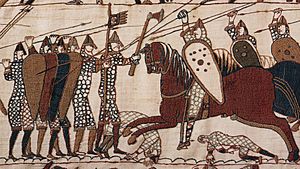
In 1088, Roger and at least three of his sons took part in a plot. They wanted to remove William Rufus, King of England from the throne. They planned to replace him with Robert Curthose, Duke of Normandy, William Rufus's older brother. This rebellion is mentioned in several old writings. One source, the Anglo-Saxon Chronicle, says that Robert Curthose's followers captured Odo, Bishop of Bayeux. This helped them control the castle of Rochester. This source names several leaders of the uprising, including three unnamed sons of Roger. It's possible Arnulf was one of them. Even though the rebellion failed, the king did not punish Roger. He allowed Roger de Poitou to get back most of his lands.
Building Power in Wales
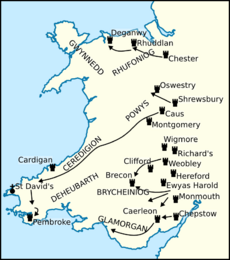
Arnulf's father was one of three close supporters of the king. They were settled along the Anglo-Welsh border, in an area called the Welsh marches. This was a border region where lords had special powers. Anglo-Norman power first entered Wales in the 1070s. But it was not until the late 1000s that more permanent settlements were planned in Wales. In 1093, invading lords fought and killed Rhys ap Tewdwr, King of Deheubarth. People at the time saw Rhys's death as the end of Welsh kingship. His death created a power vacuum, which men like Arnulf took advantage of.
The southwest Welsh "countries" of Ceredigion and Dyfed were then taken over by the newcomers. In Dyfed, Arnulf's father built a castle of earth and timber. Arnulf then made this his home. This castle was built on the highest point of a piece of land between two tidal inlets. It was where the castle of Pembroke stands today. Nothing remains of the first castle. But old writings describe it as a "slender fortress built of stakes and turf."
King William Rufus then rewarded Arnulf with a lordship based at his castle. There is strong evidence that Arnulf was made Earl of Pembroke. For example, he was called "comes" (Latin for "earl") by important people and in many old texts. The castle at Pembroke is special because it never fell into Welsh hands. Between 1097 and 1108, Arnulf's castle commander at Pembroke, Gerald de Windsor, married Rhys's daughter, Nest. According to one Welsh chronicle, Arnulf captured Rhys's young son, Hywel. Hywel later escaped after being injured. After settling in Pembroke, Arnulf seems to have lived in England. He left Gerald in charge of Pembroke as his steward.
When his father died in 1094, Arnulf's older brother, Hugh de Montgomery, inherited the earldom of Shrewsbury. Old records show that the brothers were very close. Within two years, they made a joint gift to a distant abbey. Arnulf also witnessed a gift from Hugh de Montgomery's steward to the abbey. In a Latin gift to another abbey, Arnulf gave a donation for his family, friends, and "very dear brother Hugh." This might show real affection for his brother. It could also mean that Arnulf was seen as the heir of Hugh, who was unmarried and had no children.
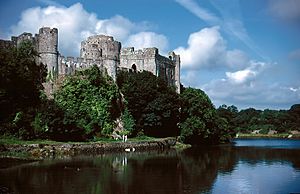
The Anglo-Norman Church tried to control the Welsh Church. The English king saw the Welsh Church as old-fashioned and different. Anglo-Normans saw themselves as religious reformers. They wanted to make the Welsh follow their rules. One way they did this was by choosing and controlling Welsh bishops. In 1095, the Bishop of St David's agreed to terms with the Archbishop of Canterbury. The Archbishop then told several important Anglo-Normans in the St David's area to treat the bishop with respect. He also told them to return lands, taxes, and churches they had wrongly taken. Arnulf and Robert de Bellême were two lords specifically named. In fact, Arnulf's steward, Gerald, damaged lands of St David's in 1097. As a friend of the archbishop, Arnulf might have been more likely to listen to this request than others.
In 1098, Hugh de Montgomery led an invasion of Gwynedd with another lord. The Anglo-Normans easily beat the Welsh. But the attackers were later defeated on Anglesey by the forces of Magnús Óláfsson, King of Norway. Arnulf seems to have learned of his brother's death about a month later in Normandy. He then traveled to an abbey and founded a small monastery at Pembroke. He did this to honor Hugh de Montgomery and his father. Arnulf probably hoped to inherit his brother's title and lands. But King William Rufus gave them to Arnulf's older brother, Robert de Bellême. Robert had captured a French count and handed him over to the king.
Arnulf's Downfall
Around 1100, the Montgomerys were one of the most important families in England. Robert de Bellême was at the peak of his power. He seemed to be the most powerful and wealthy lord in the Anglo-Norman world. He also gained the important French county of Ponthieu through his wife. His brother, Roger de Poitou, was a very powerful lord in northwest England. He held lands in many counties. Arnulf likely held the Earldom of Pembroke. This lordship made up the main part of the former Kingdom of Deheubarth. Arnulf also gained the lordship of Holderness after its previous lord was disgraced.

In August 1100, King William Rufus was killed. His younger brother, Henry, quickly took the English throne. Robert Curthose was away on a journey from the Holy Land. Henry feared an invasion from Normandy by Robert Curthose. So, one of Henry's first actions as king was to make an alliance with Robert II, Count of Flanders. This was made official in March 1101. Arnulf himself was one of the people who promised to support the English king. People who guaranteed such agreements often helped with talks between sides. This might mean Arnulf helped the king and count talk. This shows Arnulf's high status, but his time serving the king was short.
Robert de Bellême first accepted Henry as king. But by the time Robert Curthose claimed the throne in 1101, Robert de Bellême was supporting the duke. King Henry spent a year gathering evidence against Robert de Bellême. In 1102, Henry called Robert to court. He accused him of 45 different crimes against himself and Robert Curthose. Arnulf was also called and accused. Arnulf seems to have fled to Wales. Robert de Bellême made his English castles ready for Henry's attack. While Robert de Bellême made alliances with the Welsh, Arnulf reached out to the Irish. Arnulf sent Gerald of Windsor to Ireland to arrange military help from Muirchertach Ua Briain, King of Munster.
This alliance was made official by a special marriage between Arnulf and one of Muirchertach's daughters, named Lafracoth. This marriage is mentioned in several old texts. These stories are also supported by a letter from Muirchertach to Archbishop Anselm. In the letter, Muirchertach thanked the archbishop for helping "my son-in-law Arnulf" with King Henry.

We don't know exactly why Muirchertach agreed to this alliance. It certainly brought him into contact with one of Europe's leading families. He might have wanted to improve his status on the world stage. He may also have wanted to control the valuable trade route from south Wales to Waterford. His involvement might have been part of a bigger plan to increase his power in Ireland and the Irish Sea region. For Arnulf, the marriage could have been a way to improve his own status. Or, it might have been a way for Arnulf or his brother to get Muirchertach's military help. The alliance might also have been planned to keep Muirchertach's powerful ally, King Magnús, neutral. Magnús was the king who had killed Hugh de Montgomery in 1098.
King Henry was very worried about Magnús being in the region. But there is no proof that the Norwegians helped the rebels. Even though one Welsh source says Muirchertach gave the brothers military support, the rebellion failed completely.

Old records tell different stories of the rebellion. Arnulf's main role seems to have been a raid into Staffordshire. Robert de Bellême and Arnulf, with Welsh allies, attacked part of the county. They took livestock and men back to Wales. King Henry gathered an army of his lords and the old English army. Henry's army surrounded the castle of Arundel for three months before it gave up. Then the king led his forces to the castle of Tickhill, which surrendered right away. Henry later attacked the castle of Bridgnorth and took it after a three-week siege.
At this point, William Pantulf, a former follower of the Montgomerys, offered to help Robert de Bellême. But Robert refused him. So, William Pantulf joined Henry's side. He was important in convincing Robert de Bellême's Welsh allies to leave him and support the king instead. One Welsh chronicle says that a leading Welshman was paid by the king to attack his former ally's lands. After Henry's forces marched to Shrewsbury, Robert de Bellême surrendered to the king in person. Defeated, the three surviving sons of Roger de Montgomery were banished from the kingdom. Their lands and titles were taken away.
After the Rebellion

While Robert fled to Europe, Arnulf and others from the failed rebellion found safety in Ireland. Records suggest that relations between Muirchertach and Henry became bad. An English trade ban forced the Irish to make peace. This might have happened because of Muirchertach's alliance with the Montgomerys. One old text claims that Arnulf and other Normans helped Muirchertach in a military way, possibly against Magnús. However, after Magnús died in battle, this source says the Irish turned on the Normans. It claims Muirchertach forced Arnulf out of Ireland. But these details might be wrong. Magnús seems to have died fighting a different group, not Muirchertach's men. The claim that Arnulf fled Ireland might also be wrong, especially given the friendly letter between Muirchertach and Archbishop Anselm about Arnulf. This suggests Arnulf was living at Muirchertach's royal court.
It's possible Arnulf did fight in Ireland for Muirchertach. Muirchertach's marriages to Magnús's and Arnulf's families in 1102 might have been to balance out his main rival. Whatever the case, Magnús was killed the next year. And Muirchertach's forces suffered a terrible defeat. If Arnulf was indeed driven from Ireland, it might have been Muirchertach's way of fixing relations with King Henry.
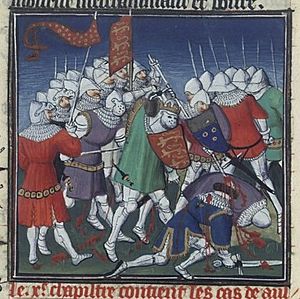
Robert Curthose first agreed to support Henry against his banished brother, Robert de Bellême. Robert de Bellême was now in Normandy and against the duke. At some point before June 1103, Arnulf seems to have betrayed his brother. One source says Arnulf took a Montgomery family castle and gave it to the duke. This might be when Arnulf sought safety in Ireland. Robert de Bellême tried to get the castle back. He even destroyed a nearby nunnery where his sister was the head nun. By 1104, Robert de Bellême's military wins against the duke forced the duke to make peace.
With Robert de Bellême and Robert Curthose now friends, Henry turned against them. He finally defeated them in battle near the castle of Tinchebray in September 1106. One Welsh source suggests Arnulf took part in the battle. But the story of Arnulf's earlier betrayal might make this unlikely. Even though there was a letter showing Archbishop Anselm helped Henry and Arnulf make peace, Arnulf never held land in England again. He seems to have traveled a lot for about twenty years. One source suggests he visited England at least once, returning from Normandy.
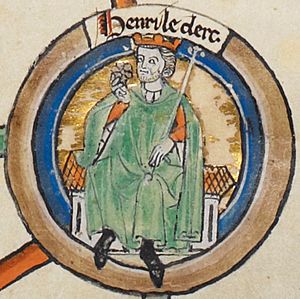
Between 1110 and 1112, Robert de Bellême was involved in uprisings in Normandy. He was encouraged by Henry's enemy, the new count of Anjou and Maine. Henry responded by bringing charges against Robert de Bellême. He finally captured him in November 1112. Robert's lands were taken away, and he was imprisoned for the rest of his life. During the early 1100s, Arnulf signed eight charters for the count of Anjou. This made Arnulf one of the count's most frequent witnesses. Around 1114, Arnulf witnessed an act between his great-niece and another lord.
Arnulf's influence at the count's court seems clear from events in 1118. That year, the people of Alençon rebelled against Henry. Alençon was a former power center for the Bellême family. The townspeople asked Arnulf to speak to the count for them. They wanted help against the injustices they faced. In what became Henry's biggest defeat, the count's troops then took the town. They surrounded the castle and crushed Henry's forces. The count then secured the castle. Arnulf, probably in his fifties by then, is not mentioned in records of this fight. However, he and his family might have been behind an uprising that happened around the same time in former Montgomery-Bellême lands in Normandy. This uprising seems to have helped Henry give back much of the former Montgomery-Bellême lands to Robert de Bellême's son in June 1119.

The next clear record about Arnulf is from 1122. His name is on a list of people remembered after the death of a churchman. The nuns of Alménêches abbey remembered him, his parents, and his younger brother Philip. So, Arnulf died sometime between 1118 and 1122. The story of Arnulf's death in one old text is probably not true. This story says that after Magnús died, Arnulf was forced out of Ireland. Then he returned about twenty years later, remarried Muirchertach's daughter, and died after a feast. Important historians say that Arnulf and his wife Lafracoth had a daughter, Alice. She married Maurice FitzGerald, Lord of Lanstephan.
Arnulf's Legacy
Many people at the time noted that members of the Montgomery family were unusually cruel, especially Robert de Bellême. One old text says Mabel was murdered by a follower, which might show she was not a pleasant person. This text describes Hugh de Montgomery as the only "mild and loveable" son of Mabel. But Welsh sources show him in a much more negative way. A sad Latin poem written by a scholar might refer to Arnulf. This poem talks about the cultural changes and hardship the Welsh faced after the Anglo-Norman conquests of 1093. It might refer to the control they suffered under Arnulf and his father.
The Montgomery family's actions show how quickly Norman families could spread across far-off regions. Norman families usually gave all their land to the oldest son. But the conquest of England and the opening up of Britain gave new opportunities for younger sons of noble families who didn't inherit land. The lives of younger sons of Anglo-Norman nobles are often not well-known. Few records exist about what they did. But Roger de Montgomery and Mabel's younger sons are an exception. Arnulf's career shows the many chances available to people of his rank. These were men who could not rely only on inheritance. They had to gain their own lands. Even though he lost his lands later, Arnulf's many regular appearances in court circles show that he kept a lot of personal respect. The wide range of places he visited might mean his skills as a negotiator were well-known and valued. Indeed, Arnulf's career shows how important personal connections were in the noble world of the Anglo-Norman era.
Arnulf's family got its name from lands now called Sainte-Foy-de-Montgommery and Saint-Germain-de-Montgommery in Calvados, Normandy. Even though descendants of Arnulf's brothers lived for several generations, the family's surname died out with Arnulf.
Images for kids
-
Seal of William Rufus. It shows a knight on horseback.
-
Robert Curthose in an old illustration.
-
The name and title of Muirchertach Ua Briain in an old manuscript.
-
The ruined Bridgnorth Castle. After it fell to King Henry's forces in 1102, the rebellion quickly ended.
-
The name and title of Magnús Óláfsson in an old manuscript.
-
A 1400s drawing of the Battle of Tinchebray in 1106. A Welsh source suggests Arnulf fought in this battle.
-
King Henry in an old illustration.
-
The abbey of Alménêches was founded by Arnulf's father, Roger de Montgomery.


